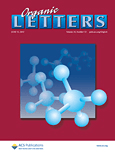
ORGANIC LETTERS
Scope & Guideline
Pioneering Discoveries in Organic Synthesis and Beyond
Introduction
Aims and Scopes
- Organic Synthesis:
The journal publishes original research on the synthesis of organic compounds, highlighting novel methodologies and synthetic strategies that contribute to the field. - Methodology Development:
A consistent focus on developing new methodologies for organic synthesis is evident, with an emphasis on efficiency, selectivity, and sustainability. - Mechanistic Studies:
Research that delves into the mechanisms of organic reactions, providing insights into reaction pathways and conditions, is a key component of the journal's offerings. - Asymmetric Synthesis:
The journal features significant contributions to asymmetric synthesis, showcasing advances in enantioselective methodologies and their applications in drug development. - Photochemistry and Photoredox Catalysis:
There is a growing emphasis on the use of light in organic reactions, particularly in the context of photocatalysis, which is reflected in the diverse range of photochemical studies published. - Electrochemistry in Organic Synthesis:
Research exploring the role of electrochemical methods in organic synthesis has gained traction, with articles discussing innovative applications and techniques. - Functionalization of Heterocycles:
The functionalization of heterocyclic compounds is prominently featured, with studies focusing on their reactivity and potential applications in medicinal chemistry.
Trending and Emerging
- Sustainable Chemistry:
Research focusing on sustainable and green chemistry practices is increasingly prevalent, with studies exploring eco-friendly reagents, recyclable catalysts, and solvent-free conditions. - Photoredox and Electrochemical Catalysis:
There is a marked increase in studies utilizing photoredox and electrochemical methods, showcasing their versatility in facilitating organic transformations. - Machine Learning and Computational Chemistry:
The integration of machine learning and computational approaches in predicting reaction outcomes and designing new synthetic routes is an emerging trend, reflecting the intersection of chemistry and technology. - Bioconjugation Techniques:
Research in bioconjugation and the development of novel bioconjugates for therapeutic applications is gaining traction, highlighting the relevance of organic synthesis in biomedical fields. - Radical Chemistry:
The exploration of radical mechanisms and their application in organic synthesis is on the rise, with innovative radical transformations being a focal point of new research. - Organocatalysis:
Organocatalysis continues to expand, with a growing number of studies emphasizing its advantages in enantioselective synthesis and diverse functionalization strategies. - Synthetic Biology and Natural Product Synthesis:
There is a renewed interest in synthetic biology approaches and the total synthesis of complex natural products, often utilizing advanced synthetic techniques and methodologies.
Declining or Waning
- Traditional Synthetic Approaches:
There is a noticeable decrease in publications focused on traditional synthetic methods that lack innovative aspects, as researchers increasingly seek more efficient and sustainable alternatives. - Classical Reagents and Solvents:
With the growing emphasis on green chemistry, studies utilizing classical reagents and solvents have become less frequent, indicating a shift towards more environmentally friendly practices. - Inorganic Catalysis:
The number of papers discussing inorganic catalysts in organic synthesis appears to be waning compared to the increasing focus on organocatalysis and photoredox methods. - Conventional Reaction Conditions:
Research employing conventional reaction conditions without novel adaptations or optimizations is less common, as the field pushes towards more sophisticated and controlled environments. - Synthetic Applications in Natural Product Chemistry:
While still relevant, the number of studies focusing solely on natural product synthesis without incorporating new methodologies or insights into reaction mechanisms has declined.
Similar Journals

JOURNAL OF SYNTHETIC ORGANIC CHEMISTRY JAPAN
Fostering collaboration in the realm of organic chemistry.JOURNAL OF SYNTHETIC ORGANIC CHEMISTRY JAPAN, published by the SOCIETY OF SYNTHETIC ORGANIC CHEMISTRY, JAPAN, is an esteemed publication specializing in the dynamic field of organic chemistry. With a rich history dating back to 1944, this journal aims to disseminate pivotal research findings and innovative methodologies in synthetic organic chemistry, fostering collaboration and knowledge exchange among researchers and professionals. Although it currently holds a modest ranking in the Q4 quartile for organic chemistry, its commitment to advancing the discipline remains steadfast. The journal primarily caters to scholars and students seeking to delve deeper into organic synthesis, highlighting original articles, reviews, and methodological studies. While access to the journal is not open, its contributions to the field are essential for anyone invested in understanding the complexities of organic chemistry. We invite you to explore the journal's offerings and enhance your expertise in synthetic organic processes.
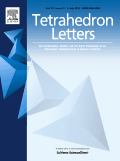
TETRAHEDRON LETTERS
Fostering Collaboration in the Chemical Sciences LandscapeTETRAHEDRON LETTERS, published by Pergamon-Elsevier Science Ltd, is a leading journal in the fields of Biochemistry, Drug Discovery, and Organic Chemistry, with a rich legacy since its inception in 1959. This prestigious journal serves as a vital resource for researchers and professionals dedicated to advancing the understanding of chemical sciences, featuring high-impact research that influences both academic and practical applications. Although it is currently classified in the third quartile across its categories for 2023, its rigorous peer-review process ensures the publication of quality research that contributes to the scientific community. With an ISSN of 0040-4039 and an E-ISSN of 1873-3581, TETRAHEDRON LETTERS is easily accessible for those in the academic landscape seeking to stay abreast of innovative developments. Researchers, professionals, and students alike will find invaluable insights and collaborative opportunities within the pages of TETRAHEDRON LETTERS, making it an essential read for anyone involved in the chemical sciences.

EUROPEAN JOURNAL OF ORGANIC CHEMISTRY
Empowering Discovery in Organic ScienceThe EUROPEAN JOURNAL OF ORGANIC CHEMISTRY (ISSN: 1434-193X; E-ISSN: 1099-0690), published by WILEY-V C H VERLAG GMBH in Germany, stands as a crucial platform for disseminating innovative research in the fields of organic, physical, and theoretical chemistry. With its inception dating back to 1998 and converging expertise until 2024, this esteemed journal has achieved a notable reputation, earning a Q2 rank in both Organic Chemistry and Physical and Theoretical Chemistry categories as of 2023, indicating its vital contribution to the academic community. Researchers and professionals will benefit from its rigorous peer-reviewed articles, which foster advancement in chemical sciences, while students can leverage its wealth of knowledge to enhance their learning. Although currently not an open-access journal, the content produced is invaluable for those looking to stay at the forefront of chemical research.

CURRENT ORGANIC SYNTHESIS
Exploring New Horizons in Organic SynthesisCURRENT ORGANIC SYNTHESIS, published by Bentham Science Publishers Ltd, is a leading journal in the field of organic chemistry and biochemistry that serves as a vital platform for researchers and professionals advancing the synthesis of organic compounds. With an ISSN of 1570-1794 and an E-ISSN of 1875-6271, it boasts a significant impact within its category, ranked in the Q3 quartile for both biochemistry and organic chemistry as of 2023. The journal covers innovative research and reviews that enhance our understanding of organic synthesis methodologies, showcasing contributions that advance the field. Operating from Sharjah, United Arab Emirates, CURRENT ORGANIC SYNTHESIS has evolved since its inception in 2005, providing access to a wealth of information essential for students, professionals, and researchers alike. While it currently does not offer open access, the journal continues to maintain a strong community of scholars dedicated to fostering dialogue and innovation in the organic sciences.
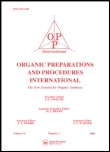
ORGANIC PREPARATIONS AND PROCEDURES INTERNATIONAL
Transforming Knowledge into Action in Organic SynthesisORGANIC PREPARATIONS AND PROCEDURES INTERNATIONAL is a prominent journal in the field of organic chemistry, published by Taylor & Francis Inc. With an ISSN of 0030-4948 and an E-ISSN of 1945-5453, this journal has been a vital resource for researchers since its inception in 1971, showcasing a broad range of methodologies, protocols, and innovative applications within organic synthesis. Although categorized in the Q4 quartile for organic chemistry, the journal provides a critical platform for researchers at all levels to disseminate their findings and to access a wealth of practical organic procedures. It currently ranks #151 out of 211 in the Scopus Organic Chemistry category, underscoring its role in advancing the discipline despite its relatively modest impact factor. The journal offers a diverse collection of scholarly articles that are essential for both professional chemists and students, enriching their understanding of organic preparation techniques. Inviting contributions that encompass the full spectrum of organic synthesis, this journal serves as a valuable conduit for knowledge exchange in the ever-evolving field of organic chemistry.
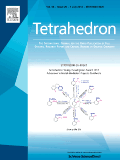
TETRAHEDRON
Catalyzing progress in biochemistry and organic chemistry.TETRAHEDRON, published by Pergamon-Elsevier Science Ltd, is a leading peer-reviewed journal that has been pivotal in advancing the fields of Biochemistry, Drug Discovery, and Organic Chemistry since its inception in 1957. With an ISSN of 0040-4020 and an E-ISSN of 1464-5416, this journal provides a platform for the dissemination of cutting-edge research and innovative methodologies that contribute significantly to the scientific community. Recognized for its rigorous editorial standards, TETRAHEDRON has been categorized in the Q3 quartile for 2023 across its relevant fields, reflecting its solid impact within the scientific sphere. Despite the current absence of Open Access options, the journal continues to engage a diverse readership, offering invaluable insights and advancements that fuel both academic and industrial applications. With an ongoing commitment to excellence, TETRAHEDRON remains an essential resource for researchers, professionals, and students aiming to stay at the forefront of chemistry and biochemistry research.

CHEMISTRY-A EUROPEAN JOURNAL
Leading the Charge in European Chemical ScienceCHEMISTRY-A EUROPEAN JOURNAL is a premier academic journal published by WILEY-V C H VERLAG GMBH, specializing in the diverse fields of chemistry and catalysis, with a distinguished focus on organic chemistry. Since its inception in 1995, the journal has established itself as an authoritative resource for researchers and professionals, currently classified in Q1 in Chemistry (miscellaneous) and Organic Chemistry, reflecting its high-quality contributions to the scientific community. With an impressive impact factor and robust Scopus rankings—#33 in Organic Chemistry and #26 in Catalysis—this journal serves as a vital platform for disseminating innovative research findings and critical advancements in chemical sciences. Although not an open-access journal, it provides valuable access options for institutions, ensuring wide reach and engagement within the scientific community. As it converges into 2024, CHEMISTRY-A EUROPEAN JOURNAL remains a key resource for anyone dedicated to advancing the frontiers of chemistry research.
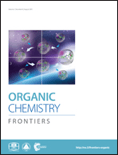
Organic Chemistry Frontiers
Driving the dialogue in organic chemistry innovation.Welcome to Organic Chemistry Frontiers, a premier academic journal published by the Royal Society of Chemistry, dedicated to advancing the field of organic chemistry. With an impressive Q1 ranking in the 2023 category of Organic Chemistry and a notable Scopus rank of 34 out of 211, this journal provides a vital platform for researchers and professionals to disseminate innovative research, cutting-edge methodologies, and comprehensive reviews. Serving as an open-access journal, Organic Chemistry Frontiers aims to enhance the visibility and accessibility of critical research findings in the organic chemistry domain, fostering collaboration and dialogue among scientists worldwide. Since its inception in 2014, it has consistently published high-quality articles that contribute to the progression of knowledge and application in organic chemistry, establishing itself as a cornerstone for students and scholars striving to deepen their understanding and drive forward their research endeavors.

SYNTHETIC COMMUNICATIONS
Pioneering Discoveries in Synthetic MethodologiesSynthetic Communications, published by Taylor & Francis Inc, stands as a pivotal resource in the field of organic chemistry since its inception in 1971. With an ISSN of 0039-7911 and an E-ISSN of 1532-2432, this journal has established a commendable reputation, holding a Q3 ranking in organic chemistry by 2023, reflecting its contributions to the discipline and positioning it within the 50th percentile according to Scopus rankings. Targeted towards researchers, professionals, and students alike, Synthetic Communications aims to disseminate significant advancements in synthetic methodologies and reactions, facilitating the exchange of innovative ideas and enhancing collaborative efforts in the scientific community. Although not an open-access journal, it offers a wealth of valuable research content that is crucial for anyone dedicated to pushing the boundaries of organic chemistry.

ORGANIC SYNTHESES
Unveiling Innovations in Organic ChemistryORGANIC SYNTHESES is a prestigious journal dedicated to the field of organic chemistry, published by ORGANIC SYNTHESES INC. Since its inception in 1946, the journal has served as a vital platform for researchers, educators, and practitioners in chemistry, showcasing significant findings and methodologies that advance the discipline. Although it currently does not offer open access, it is recognized for its rigorous peer-review process and its contribution to standardizing organic synthesis methods. With an ISSN of 0078-6209 and an E-ISSN of 2333-3553, the journal's impact reflects its quality, with a current Scopus ranking placing it in the fourth quartile in both Organic Chemistry and Physical and Theoretical Chemistry. This positioning underscores its critical role in fostering knowledge and innovation within these fields. Researchers and students alike will find ORGANIC SYNTHESES an essential resource for staying informed on contemporary practices and discoveries in organic synthesis.